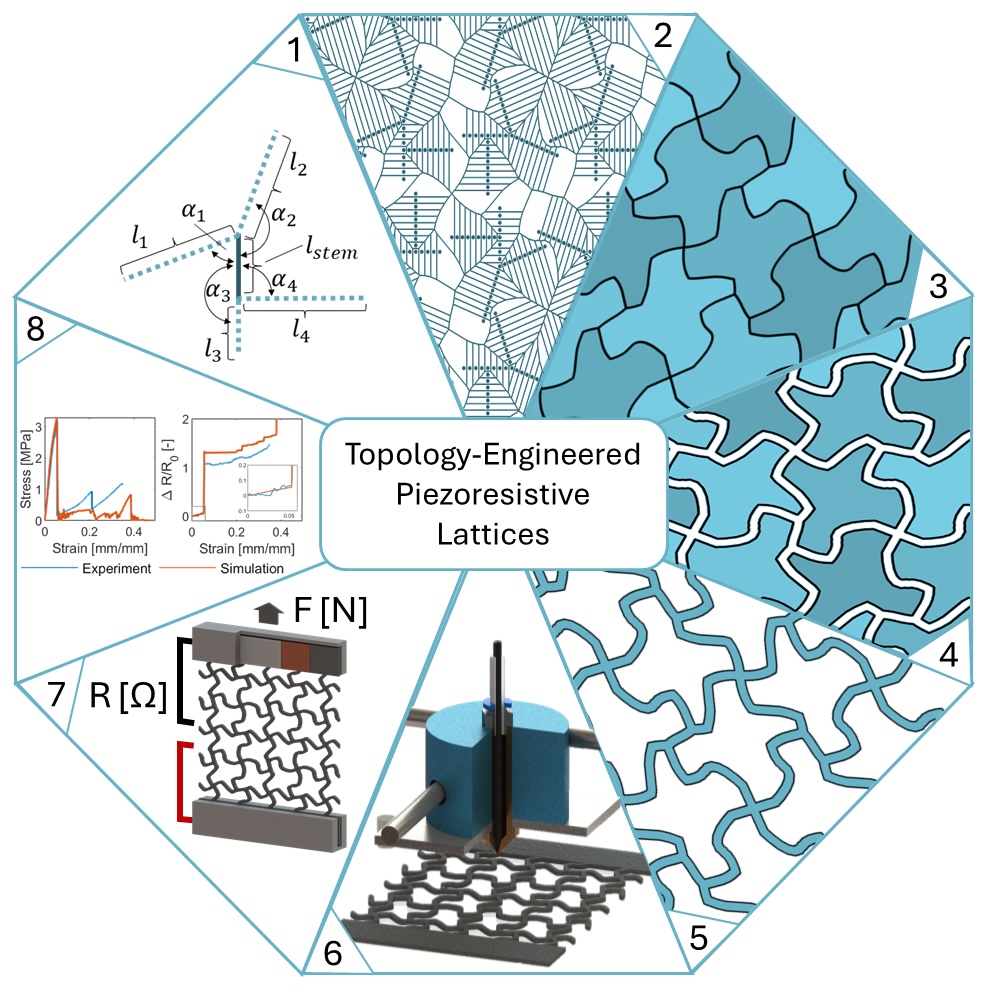New smart plastics could harness unusual properties of auxetic materials
Published: 14 July 2025
New advances in 3D printed ‘smart’ plastics with unusual deformation properties could lead to a new generation of materials designed to monitor their own condition in real time.
New advances in 3D printed ‘smart’ plastics with unusual deformation properties could lead to a new generation of materials designed to monitor their own condition in real time.
An international team led by engineers from the University of Glasgow are behind the development, which could lead to applications in everything from medical implants to impact-resistant vehicle structures.
In a new paper published in Materials Horizons, the team report a breakthrough in developing and designing novel auxetic structures using high-performance engineering plastics. The research showcases how additive manufacturing can be used to create finely tuned, self-monitoring materials with programmable properties such as strength, stretchability, and strain sensitivity.
Auxetic materials behave very differently from ordinary materials. Most materials get thinner when stretched. Auxetic materials do the opposite, becoming wider when pulled. This unique behaviour, made possible by carefully engineered internal geometries, gives them extraordinary mechanical characteristics, such as enhanced energy absorption and improved damage tolerance.

The team explored how to exploit these counterintuitive properties using polyetheretherketone (PEEK), a tough, lightweight and biocompatible plastic already widely used in engineering and biomedical applications. By 3D printing intricate auxetic lattices from PEEK, the researchers could precisely control both mechanical and electrical behaviour.
“We’ve shown that it’s possible to design PEEK lattices that are not only auxetic but also capable of sensing strain and damage without the need for embedded electronics,” said Professor Shanmugam Kumar, corresponding author of the study and a materials and additive manufacturing expert at the University of Glasgow’s James Watt School of Engineering. “This could enable new applications in smart orthopaedic implants, aerospace skins, or even wearable technologies.”
To develop the new materials, the researchers fabricated a family of 2D lattices from four types of PEEK-based feedstock, including three that were infused with carbon nanotubes. These nanotubes give the plastic electrical conductivity, allowing it to act like a sensor. As the lattices deform under mechanical strain, their internal electrical resistance changes in measurable ways. This phenomenon, called piezoresistivity. allows the materials to ‘self-sense’ how they are being stretched, compressed or impacted.
The designs were based on repeating units shaped like a double-ended 'Y', creating a distinctive branch-stem-branch layout. This framework enabled the researchers to realise a wider range of designs and to fine-tune the mechanical properties of each structure by changing parameters like thickness, angle, and spacing. The result was a catalogue of materials with varying levels of auxeticity, stiffness, strength, and sensitivity to strain and/or damage.
The team also created a powerful computational model that predicts how these materials behave under different loading conditions. Their predictive tool accurately captures how the lattices’ electrical resistance changes in response to mechanical stress, allowing researchers to optimise material behaviour in simulation before 3D printing a physical sample.
“By combining design, fabrication, and predictive modelling, we can now create materials that behave exactly as needed for a given application, whether that’s absorbing impact, sensing damage, or deforming in controlled ways,” said Professor Kumar. “That means we can move towards a 'design for failure' philosophy where materials are not only strong and lightweight, but also intelligent, able to monitor their own integrity over time.”
The current study builds on earlier work published in Additive Manufacturing by the same group, published last year, where they used another plastic, polylactic acid (PLA), infused with carbon black to create a library of 56 different auxetic lattice structures. PLA is biodegradable, making it ideal for short-term or disposable applications.
In that previous work, the team developed lattices that could stretch dramatically, sense tiny strains, or withstand high loads, all by tweaking their internal geometry. Like the PEEK lattices, the PLA-based structures could conduct electricity and respond to mechanical deformation through changes in piezoresistivity.
“The PLA-based designs are ideal for temporary applications like smart scaffolds in low-load biomedical implants, or disposable sensors embedded in sports gear,” added Professor Kumar. “The PEEK-based materials, on the other hand, open the door to permanent, load-bearing smart components in much more demanding environments.”
A key enabler in both studies is the development of in-house software tools that automate and accelerate the design and evaluation process. These digital tools help engineers explore the vast design space of architected materials more quickly and cost-effectively than ever before.
“We’re essentially giving designers a toolkit for building the next generation of multifunctional materials, ones that are as intelligent as they are strong,” said Professor Kumar. “We believe this could be transformative for several sectors, from personalised medicine to aerospace safety and structural health monitoring.”
The research, titled ‘Topology-Engineered Piezoresistive Lattices with Programmable Strain Sensing, Auxeticity, and Failure Modes’, was supported by funding from the Department of Science and Technology, India, the National Science Foundation (USA), and the UK’s Engineering and Physical Sciences Research Council (EPSRC). Collaborators included researchers from the Polytechnic University of Marche (Italy) and Texas A&M University (USA).
First published: 14 July 2025
<< July

